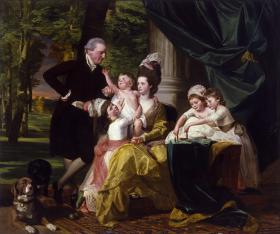- Provide each student with a copy of the Image Analysis Chart. Assign the class to examine The Mason Children: David, Joanna, and Abigail and Sir William Pepperrell and His Family. Ask the students to record their observations on the Image Analysis Chart.
- Have the class read Nan Wolverton's article on the emergence of childhood play, "Toys and Childhood in the Early Nineteenth Century."
- Divide the class into pairs. Assign each pair of students to review the written material accompanying the image of The Mason Children: David, Joanna, and Abigail.
- Assign each pair of students to combine their information on the Image Analysis Chart to create the best compilation of information from the interpretation of the paintings and the information from the article.
- Assign each student pair to write collaboratively a one-page paper explaining how John Singleton Copley's depiction of children communicates new ideas about childhood emerging at the end of the 18th century.
- Hold a brief class discussion focused on comparing childhood in the colonial era and the present day.
- Successful use of the Image Analysis Charts will demonstrate students’ ability to analyze artistic images for meaning, style, and composition.
- Completion of an effective collaborative paper will determine students’ understanding of the societal role of children from the 17th to 19th centuries.
- Class discussion will demonstrate the student's analysis of the impact of the societal changes on American children as portrayed in art.
Colonial
Composition
Interpretation
Mood
Setting
Style
Subject
Freake artist painting of Mason children
For comparison to British images of childhood:
“The Oddie Children” by Sir William Beechey (1789)
John Singleton Copley was never content with being the preeminent portrait painter in a provincial outpost of the British Empire. While building his career and fortune in Boston, he dreamed of making the voyage to Europe to study the works of the old masters and prove himself against the best of London’s painters. Finally, in 1774, after years of vacillation, Copley left for Europe. His exit was surely hastened by the increasing political turmoil in the colonies. Though he assiduously avoided politics and courted the patronage of both high Tories and such rebels as Samuel Adams and John Hancock, revolutionary Boston was no place for a society painter. Leaving America, never to return, Copley looked forward to a more hopeful future abroad.
After a study tour of Italy, Copley and his family settled in London, where he set about the daunting task of establishing himself as a painter of the front rank. As might be expected, a number of his earliest patrons were fellow Americans, including Sir William Pepperrell (1746–1816), who had arrived in London a year after Copley. Sir William was the grandson and heir of William Pepperrell (1696–1759), a prosperous merchant, politician, and soldier—and the first native-born American to be awarded the title of baronet. The younger Pepperrell further enhanced the family’s stature by marrying the daughter of Isaac Royall, one of the wealthiest men in British America. However, during the turbulent years leading up to the American Revolution, Pepperrell remained steadfastly loyal to the British Crown. Fearing mob violence and the wholesale confiscation of his property, he sailed from Boston with his family toward an uncertain exile. Soon after arriving in 1775, Pepperrell commissioned Copley to paint a family portrait. When finished, the painting was more than the standard, flattering celebration of a proud, illustrious family. It also symbolized with poignant irony the tragedy of the Pepperrells.
No doubt in accord with the wishes of his client, Copley staged an extravagant, yet intimate portrayal of Sir William, his wife, Elizabeth, and their three daughters and newborn son. He invented a setting that is neither a proper interior nor a landscape, but a studio fantasy. The colossal fluted column, Baroque drapery, plush “Turkey” carpet, and the inviting glimpse of a twilight park were stock devices in royal and aristocratic portraiture, signifying wealth, gentility, and dominion. Within this setting the Pepperrells are presented in a moment of studied informality. Striking a pose of courtly nonchalance, Sir William presides over the happy domestic scene. His solemn and beautiful wife holds up to him their gleeful son. The oldest daughter embraces her brother while turning a coquettish eye to the viewer. At right, the two younger Pepperrell daughters play at skittles. The boy, heir to his father’s title and fortune, is the center of the painting and of his parents’ hopes.
Unfortunately, the portrait is an elaborate fiction, perpetrated by client and artist to mask an unacceptable reality. The Pepperrells were not English gentry, but exiles, bereft of country and much of their fortune. Moreover, Elizabeth Royall Pepperrell had died in Boston two years before the portrait was painted. (For her likeness, Copley probably relied upon a portrait miniature.) For the widower and his children, Copley offered a comforting vision of what might have been, had not war and death come knocking.
The painting was equally important for Copley in promoting his nascent career in England. Exhibited in the annual exhibition of the Royal Academy in 1778, it served to advertise the artist’s abilities. He demonstrated his mastery at organizing a complex arrangement of figures, fitting the family within a strict pyramidal composition and linking each figure with graceful and telling gestures. The American flaunted his virtuosic skills at rendering the sheen and textures of costly fabrics. He also theatrically orchestrated the colors and the play of light and shadow, spotlighting the family against a background of deep, luxuriant greens. The painting is a sumptuous tapestry, every part enlivened: the spaniels are treated with nearly as much attention as their masters. Shortly after arriving in London Copley had written that “you must be conspecuous in the Croud if you would be happy and great.” With the exhibition of Sir William Pepperrell and His Family, Copley signaled to the British public that he had arrived.


